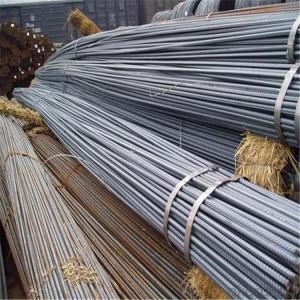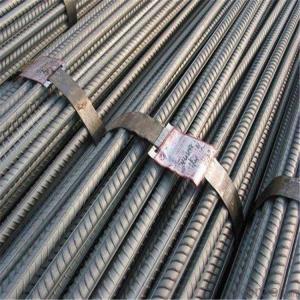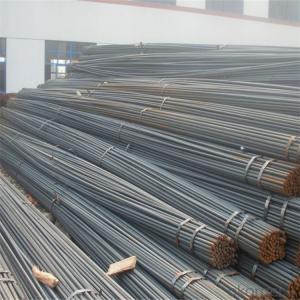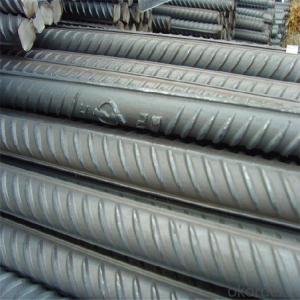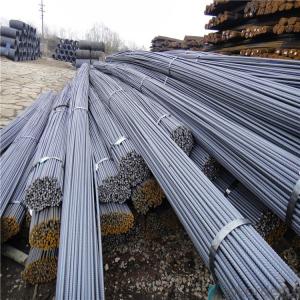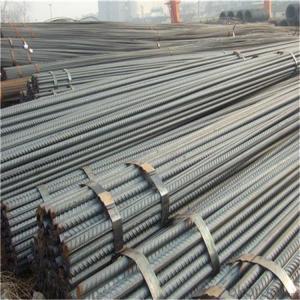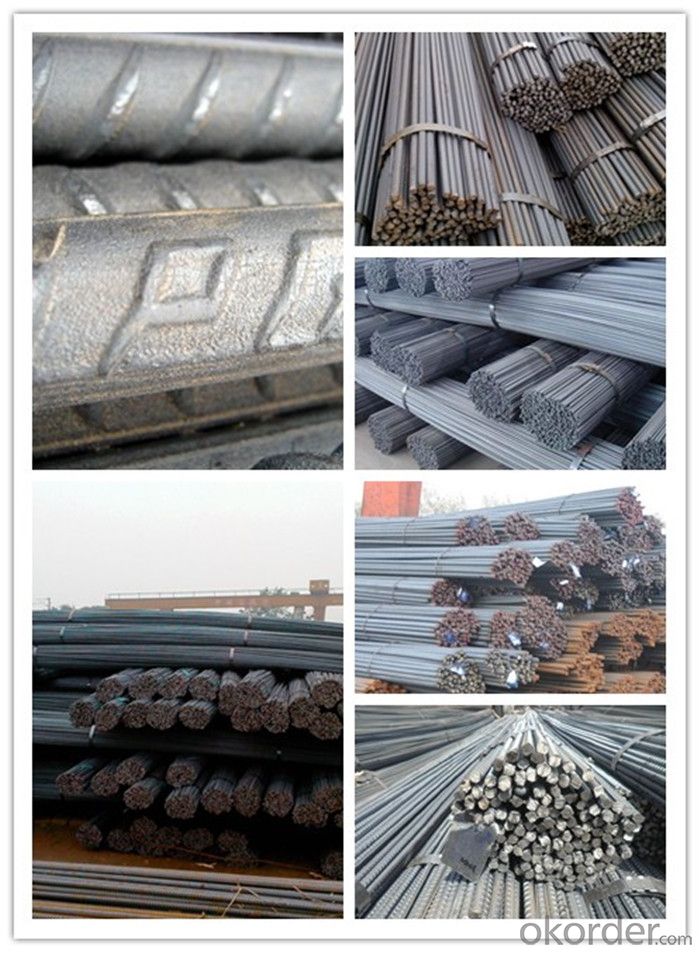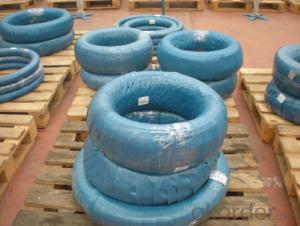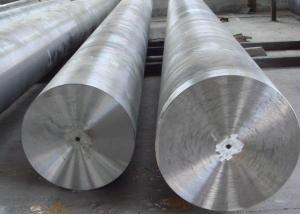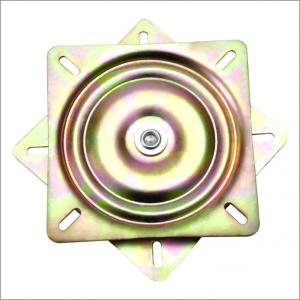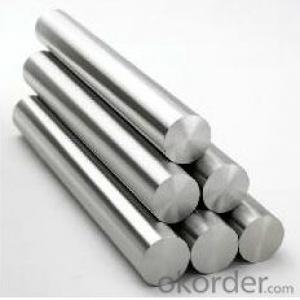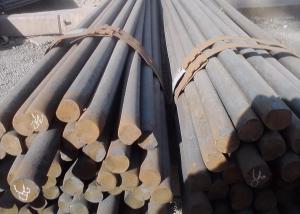HRB335 Steel Rebar Deformed Steel Bar
- Loading Port:
- Tianjin
- Payment Terms:
- TT OR LC
- Min Order Qty:
- 120 m.t.
- Supply Capability:
- 50000 m.t./month
OKorder Service Pledge
OKorder Financial Service
You Might Also Like
Item specifice
HRB335 Steel Rebar Deformed Steel Bar
Description of HRB335 Steel Rebar Deformed Steel Bar
1, Diameter: 5.5mm-10mm HRB335 Steel Rebar Deformed Steel Bar
10m- 40mm HRB335 Steel Rebar Deformed Steel Bar
2, Length: 6m, 9m, 12m or customized
3, Standard: GB, ASTM, AISI, SAE, DIN, JIS, EN
2, Produce Process: hot rolled or forged to get the steel round bar and plate
3, Heat Treatment: annealing, normalizing, tempering, quenching
4, Surface Treatment: Black
5, Quality Assurance: We accept third party inspection for all orders.
Chemical Composition of HRB335 Steel Rebar Deformed Steel Bar
Grade | Technical data of the original chemical composition(%) | |||||
Reinforcing steel bar HRB335 | C | Mn | Si | S | P | B |
≤0.25 | ≤1.60 | ≤0.80 | ≤0.045 | ≤0.045 | >0.0008 | |
Physics Capability | ||||||
Yield Strength(N/cm2) | Tensile Strength(N/cm2) | Elongation(%) | ||||
≥ 335 | ≥490 | ≥16 | ||||
Reinforcing steel bar HRB400 | C | Mn | Si | S | P | B |
≤0.25 | ≤0.16 | ≤0.80 | ≤0.045 | ≤0.045 | 0.04-0.12 | |
Physics Capability | ||||||
Yield Strength(N/cm2) | Tensile Strength(N/cm2) | Elongation(%) | ||||
≥ 400 | ≥ 570 | ≥ 14 | ||||
Products Show of HRB335 Steel Rebar Deformed Steel Bar
Company Information
CNBM International Corporation is the most important trading platform of CNBM group.
Whith its advantages, CNBM International are mainly concentrate on Cement, Glass, Iron and Steel, Ceramics industries and devotes herself for supplying high qulity series of refractories as well as technical consultancies and logistics solutions.


F A Q
1, Your advantages?
professional products inquiry, products knowledge train (for agents), smooth goods delivery, excellent customer solution proposale
2, Test & Certificate?
SGS test is available, customer inspection before shipping is welcome, third party inspection is no problem
3, Factory or Trading Company?
CNBM is a trading company but we have so many protocol factories and CNBM works as a trading department of these factories. Also CNBM is the holding company of many factories.
4, Payment Terms?
30% TT as deposit and 70% before delivery.
Irrevocable L/C at sight.
5, Trading Terms?
EXW, FOB, CIF, FFR, CNF
6, After-sale Service?
CNBM provides the services and support you need for every step of our cooperation. We're the business partner you can trust.
For any problem, please kindly contact us at any your convenient time.
We'll reply you in our first priority within 24 hours.
- Q:How does special steel contribute to the manufacturing industry?
- Special steel contributes to the manufacturing industry by providing superior strength, durability, and performance in various applications. Its unique composition and properties allow for the production of high-quality components and machinery that can withstand extreme conditions, ensuring safety and reliability. Additionally, special steel enables manufacturers to create lightweight and efficient products, leading to cost savings and environmental sustainability.
- Q:How does special steel perform in power generation applications?
- Special steel is highly valued in power generation applications due to its exceptional properties and performance. Power generation equipment such as gas turbines, steam turbines, and nuclear reactors operate under extreme conditions of high temperature, pressure, and corrosive environments. Special steel alloys, specifically designed to withstand these harsh conditions, offer several advantages in power generation applications. Firstly, special steel exhibits excellent heat resistance, making it ideal for power generation equipment that operates at high temperatures. This steel has a high melting point, enabling it to maintain its structural integrity and mechanical properties even at elevated temperatures. This is crucial for gas turbines and steam turbines, which generate power by converting thermal energy into mechanical energy. Secondly, special steel possesses superior strength and toughness, making it well-suited for power generation applications that require reliable and durable components. Power plants operate continuously, often for long periods, and are subject to significant mechanical stresses. Special steel can withstand these loads without deformation or failure, ensuring the safe and efficient operation of power generation equipment. Furthermore, special steel exhibits excellent resistance to corrosion and oxidation, which are prevalent in power generation environments. This steel is designed to resist the corrosive effects of high-temperature gases, steam, and water, ensuring the longevity of power generation equipment. Corrosion-resistant alloys of special steel are commonly used in power plants to prevent material degradation and maintain operational efficiency. In addition to its mechanical and corrosion-resistant properties, special steel also offers excellent weldability and machinability. This makes it easier to fabricate and assemble power generation equipment, reducing production time and costs. Overall, special steel is a reliable and high-performance material for power generation applications. Its exceptional heat resistance, strength, toughness, corrosion resistance, and weldability make it an ideal choice for gas turbines, steam turbines, and other power generation equipment. The use of special steel in power generation contributes to increased efficiency, reliability, and longevity of these critical systems.
- Q:How is tool and die steel used in the manufacturing of molds and dies?
- Tool and die steel is an essential material used in the manufacturing of molds and dies due to its high strength, toughness, and wear resistance properties. It is used to create precise and durable molds and dies that are capable of withstanding the high pressures and temperatures involved in the manufacturing process. This steel is carefully designed and machined to produce intricate shapes and forms required for various industries such as automotive, aerospace, and electronics. Tool and die steel ensures the longevity and accuracy of molds and dies, leading to efficient and high-quality production in manufacturing processes.
- Q:Can special steel be used in the production of luxury goods?
- Yes, special steel can be used in the production of luxury goods. Special steel is known for its exceptional strength, durability, and unique properties, making it an ideal material for creating high-quality and exclusive products. Its use in luxury goods such as watches, jewelry, high-end cutlery, and designer accessories can enhance their aesthetic appeal, performance, and overall value.
- Q:How does special steel contribute to the manufacturing of springs?
- Special steel plays a crucial role in the manufacturing of springs due to its unique properties and characteristics. Springs are mechanical components that store and release mechanical energy, and special steel provides the necessary strength, durability, and resilience for these applications. One of the key contributions of special steel to spring manufacturing is its high tensile strength. Special steel alloys are designed to have a higher strength-to-weight ratio compared to regular steels, allowing springs to withstand heavy loads and high stresses without deforming or breaking. This property ensures the longevity and reliability of springs, even in demanding applications such as automotive suspensions or industrial machinery. Furthermore, special steel exhibits excellent elasticity and resilience. Springs need to retain their shape and performance over repeated cycles of compression and extension. Special steel alloys are formulated to have a high elastic limit, meaning they can be deformed significantly and still return to their original shape without permanent deformation. This property allows springs to absorb and release energy reliably, providing the desired mechanical functionality in various applications. Another important contribution of special steel to spring manufacturing is its resistance to fatigue and corrosion. Springs are often subjected to cyclic loading, which can lead to fatigue failure over time. Special steel alloys are designed to have enhanced fatigue resistance, allowing springs to endure millions of cycles without failure. Additionally, special steel can be further treated or coated to enhance its corrosion resistance, which is crucial for springs exposed to harsh environments or chemicals. In conclusion, special steel significantly contributes to the manufacturing of springs by providing high tensile strength, excellent elasticity and resilience, fatigue resistance, and corrosion resistance. These properties ensure the durability, performance, and longevity of springs, making them essential components in various industries such as automotive, aerospace, and manufacturing.
- Q:What are the challenges in machining high-speed special steel?
- Several challenges arise when machining high-speed special steel due to its unique properties and characteristics. Its extreme hardness presents one of the main obstacles, making cutting and shaping difficult. High-speed special steel typically has a high carbon content and undergoes heat treatment to enhance its hardness, resulting in increased wear on cutting tools. The increased hardness of this steel also leads to elevated heat generation during the machining process. This heat can cause thermal distortion and impact the dimensional accuracy of the final product. To counteract this, specialized cooling techniques and cutting tools with advanced coatings must be used to dissipate heat and maintain stability. Another challenge is the brittleness of high-speed special steel. It tends to have low toughness and is susceptible to cracking and chipping during machining operations. To minimize the risk of tool failure and excessive stress, careful selection of cutting parameters such as cutting speed, feed rate, and depth of cut is necessary. Furthermore, high-speed special steel often contains alloying elements like tungsten, vanadium, and cobalt, which can further complicate the machining process. While these elements increase the strength and wear resistance of the steel, they also make it more challenging to machine. Effective machining of these alloys and achieving desired surface finishes requires specialized tool materials and cutting strategies. Additionally, the cost of high-speed special steel is often significantly higher than that of conventional steels, adding to the challenges of machining. The high tooling costs associated with the cutting tools required for machining this steel can be a substantial investment. Overall, machining high-speed special steel necessitates advanced cutting techniques, specialized tooling, and careful consideration of cutting parameters to overcome the challenges posed by its extreme hardness, brittleness, and alloying elements.
- Q:How does special steel contribute to the manufacturing of automotive engine components?
- Special steel plays a crucial role in the manufacturing of automotive engine components by providing enhanced strength, durability, and performance. Due to its unique properties, special steel is used in various critical engine parts, such as crankshafts, camshafts, connecting rods, valve springs, and cylinder heads. One of the primary benefits of special steel in automotive engine components is its exceptional strength. Engine parts made from special steel can withstand high stress, heavy loads, and extreme temperatures without deformation or failure. This strength ensures that the engine operates efficiently and reliably, even under demanding conditions. Moreover, special steel offers superior durability, which is essential for the longevity and performance of engine components. Special steel's resistance to wear, corrosion, and fatigue ensures that the engine parts maintain their functionality over an extended period. This durability translates into increased lifespan and reduced maintenance requirements for the engine, ultimately leading to higher customer satisfaction and lower costs for vehicle owners. The use of special steel in automotive engine components also contributes to improved performance. Special steel allows for the creation of lightweight components, reducing the overall weight of the engine and improving fuel efficiency. Additionally, the high precision and dimensional accuracy achievable with special steel manufacturing processes result in better engine performance, reduced friction, and improved power output. Furthermore, special steel offers excellent machinability, which simplifies the manufacturing process of engine components. Its ability to be easily formed, cut, and shaped enables the production of complex designs and intricate features, leading to enhanced efficiency and performance in the final product. In summary, special steel is vital in the manufacturing of automotive engine components due to its exceptional strength, durability, and performance. Its usage results in engines that are more reliable, efficient, and long-lasting, ultimately contributing to the overall quality and satisfaction of vehicles.
- Q:How does special steel perform in cryogenic corrosion resistance?
- Special steels possess exceptional capabilities in terms of resisting corrosion in cryogenic environments. Unlike regular steels, which tend to become brittle and prone to corrosion when exposed to extremely low temperatures, special steels are specifically engineered to endure such conditions while maintaining their mechanical properties and corrosion resistance. The remarkable performance of special steels in cryogenic settings can be primarily attributed to their composition and microstructure. These steels are typically infused with elements like nickel, molybdenum, and nitrogen, which significantly enhance their ability to withstand corrosion at low temperatures. Additionally, the microstructure of special steels is meticulously controlled, resulting in a fine grain size and a uniform distribution of alloying elements. This microstructure contributes to the steel's capacity to resist corrosion and retain its mechanical strength even in cryogenic temperatures. Furthermore, special steels undergo rigorous testing procedures to ensure their suitability for cryogenic applications. They are subjected to low-temperature impact tests, which evaluate their toughness and resistance to brittle fracture. These tests verify that the steel can endure the stresses and strains imposed by cryogenic conditions without experiencing failure. In conclusion, special steels exhibit exceptional resistance to cryogenic corrosion due to their distinct composition, microstructure, and comprehensive testing. They are the preferred choice for applications that demand reliable performance in extremely low temperatures, such as in the aerospace, energy, and scientific research industries.
- Q:What are the different methods for tempering special steel?
- There are several different methods for tempering special steel, including air tempering, oil tempering, water tempering, and salt bath tempering. Air tempering involves heating the steel to a specific temperature and then allowing it to cool in air. Oil tempering involves heating the steel to a specific temperature and then quenching it in oil. Water tempering is a similar process, but the steel is quenched in water instead. Salt bath tempering involves heating the steel in a molten salt bath to achieve the desired tempering temperature. Each method has its own advantages and is chosen based on the specific properties and requirements of the steel being tempered.
- Q:What are the different methods of improving the strength of special steel?
- There exist various approaches that can be utilized to enhance the strength of special steel. One prevalent technique involves the process of alloying. By incorporating specific elements like manganese, chromium, or vanadium into the steel, its strength and hardness can be significantly augmented. These alloying elements form robust and stable compounds with the steel, thereby enhancing its overall strength. Another method entails heat treatment. This process entails subjecting the steel to controlled heating and cooling processes in order to modify its microstructure. For instance, quenching and tempering can be employed to increase the strength and hardness of the steel by creating a hardened martensitic structure. Additionally, precipitation hardening is a heat treatment technique that involves the formation of fine particles within the steel matrix, resulting in improved strength. Cold working is also a widely utilized technique for strengthening special steel. By subjecting the steel to plastic deformation at low temperatures, its grain structure becomes elongated, and dislocations are introduced. This leads to an increase in the strength and hardness of the steel. Furthermore, surface treatments can be implemented to enhance the strength of special steel. For instance, carburizing or nitriding can be utilized to introduce carbon or nitrogen into the surface layer of the steel, resulting in the formation of a hard and wear-resistant surface. Moreover, advancements in metallurgical technology have introduced techniques such as powder metallurgy and rapid solidification. These methods involve the production of steel with fine and homogeneous microstructures, leading to improved strength and performance. In summary, the methods for improving the strength of special steel encompass alloying, heat treatment, cold working, surface treatments, and advanced metallurgical technologies. These techniques can be customized to meet specific requirements, enabling the production of high-strength and high-performance steel for various applications.
1. Manufacturer Overview |
|
|---|---|
| Location | |
| Year Established | |
| Annual Output Value | |
| Main Markets | |
| Company Certifications | |
2. Manufacturer Certificates |
|
|---|---|
| a) Certification Name | |
| Range | |
| Reference | |
| Validity Period | |
3. Manufacturer Capability |
|
|---|---|
| a)Trade Capacity | |
| Nearest Port | |
| Export Percentage | |
| No.of Employees in Trade Department | |
| Language Spoken: | |
| b)Factory Information | |
| Factory Size: | |
| No. of Production Lines | |
| Contract Manufacturing | |
| Product Price Range | |
Send your message to us
HRB335 Steel Rebar Deformed Steel Bar
- Loading Port:
- Tianjin
- Payment Terms:
- TT OR LC
- Min Order Qty:
- 120 m.t.
- Supply Capability:
- 50000 m.t./month
OKorder Service Pledge
OKorder Financial Service
Similar products
New products
Hot products
Related keywords
